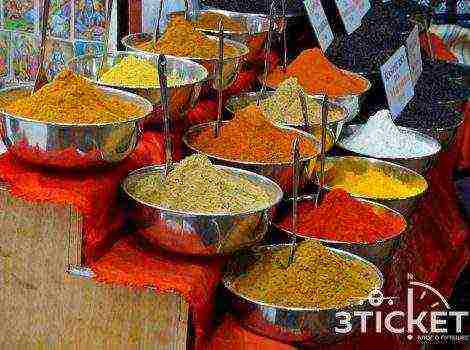In recommendations for the care of indoor plants, there is often advice: watering should be moderate and regular. How to water the plants on time, especially if the collection exceeds 10-15 pots? We suggest using wick irrigation.
Wick irrigation method
Saintpaulias, gloxinia, achimenes, episis, hirita and other plants that need to be grown in small pots, in a loose substrate, have to be watered every other day. When keeping a large collection, or when you need to go on vacation, this can be a major problem. But the wick irrigation method comes to the rescue, in which water and nutrient solution rise to the roots of the plant along a synthetic cord.
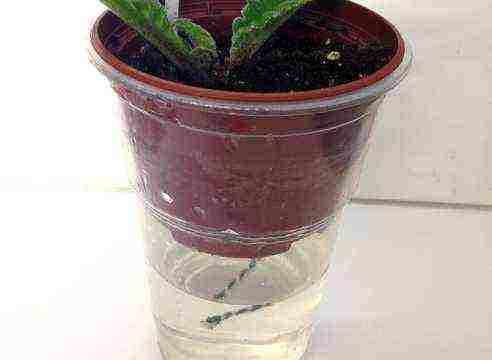
pros
- plants grow and bloom quickly
- watering time is reduced to 1 - 2 times a month, depending on conditions
- you can leave without fear of plant death
- drying out of roots is excluded
- flowering in such plants is usually brighter and more luxuriant, and the flowers are larger.
Minuses
- in a humid room at temperatures below + 18 ° С there is a risk of root rot and the occurrence of fungal infections
- vital processes pass faster, therefore aging occurs faster
- plants grown on wicks turn out to be large - to save space, alas, will not work.
Growing on a wick in a land mix
The soil needs to be picked up in accordance with the requirements of a specific plants. For wick irrigation, there must be more perlite in it by 30-40% of the total volume so that the substrate is loose. You can fertilize plants on a wick in the usual way, pouring a small amount of fertilizer on top of it. It is necessary to ensure that fertilizers do not fall into a container with water, or use foliar dressing. If the foliage begins to turn yellow and discolor, it is better to transplant the plant into fresh soil.
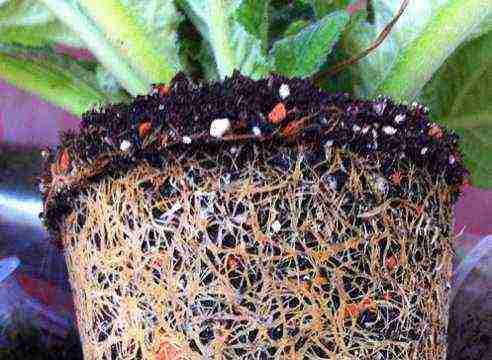
Growing plants on a wick in a landless mixture
One way to grow is in a landless mixture. The composition of the soil for Gesneriaceae is peat + perlite in a 1: 1 ratio. This mixture is very poor, therefore, when wick watering the plant grown in containers with nutrient solution, using fertilizers such as Etisso, Pokon, Kemira Lux and others.
The approximate formula for growing in nutrient solution is (N: P: K) 5: 5: 5 + trace elements. You need to dilute at the rate of 1: 1000. If this fertilizer is Etisso Hydro, then the recommended dose for the nutrient solution is 3 ml per 1 liter of water.
Cord for making a wick
The cord should be made of synthetic material to prevent decay. Make sure it conducts well. To do this, take a small dry section of the cord and immerse the end in water - it should get wet quickly. For a pot with a diameter of 9 cm, a cord with a diameter of 1.5-2 mm is needed. Try to keep it long enough to reach the bottom of the container.
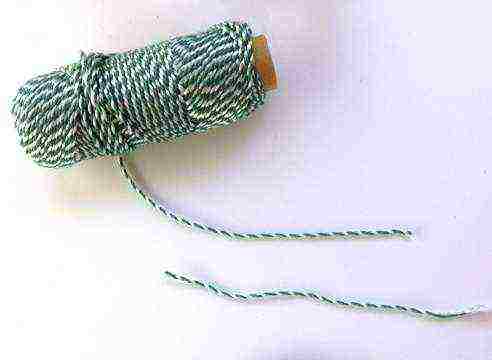
For the first 2 weeks, check whether the earthen lump is sufficiently moistened, whether the plants have lost turgor, whether the water in the container is decreasing. If the soil is dry, stretch an additional cord, if it is waterlogged, observe the plant for several days: the roots may be underdeveloped or the cord is too thick.
Container for wick irrigation
The container should be plastic, like the pot you are planting in. Plastic is easy to clean and disinfect. The container can be a plastic cup or a container with a lid and a hole in it. Transparent containers are much more convenient - you can monitor the water level. A plastic pallet with a grid can be used as a common container.
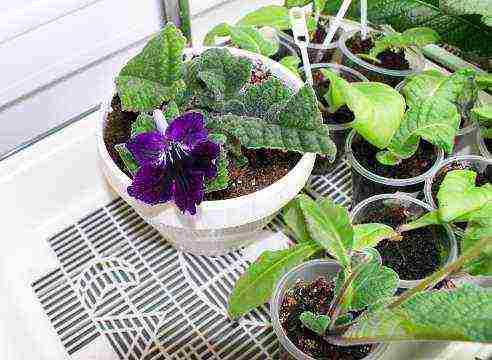
Sometimes green algae form on the walls of the cups, they do not harm the plant in any way - you just need to wash the container.
Potting the cord
In some sources, it is recommended to lay the cord at the bottom in a circle:

But the best way to pull the wick is diagonally:

The hole for pulling the cord should be in the middle of the bottom of the pot, however, plastic pot manufacturers mainly make holes along the edge, so the wetting of the earthen will be uneven. Accordingly, the development of roots and plants will also be uneven.
If you distribute the wick unevenly, only one half of the earthy ball will be wetted. For example, the roots of an improperly planted streptocarpus will dry out where moisture does not enter, and half of the aerial part may die.
General rules for wick irrigation
Never compact the soil when planting - air for the roots is as important as moisture. It is advisable not to use a lot of high-moor peat as a planting mixture, otherwise it will be difficult to wet it.
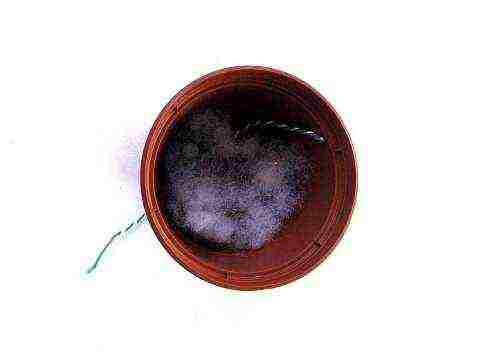
It is best to use a synthetic winterizer as drainage - it conducts moisture and air, and is chemically neutral. Coarse perlite can also be used. So that he does not get enough sleep, you need to additionally put a net on the bottom of the pot.
For the plant to be able to assimilate a sufficient amount of water constantly flowing through the wick, it must have well-developed roots. For about 2 weeks after transplanting, try to keep the plant in a greenhouse, and after that for another 1-2 weeks - under normal conditions and on ordinary watering, preferably through a pallet so that the earthen lump does not condense. For better root development, plants can be watered with a solution of zircon or eco-gel (according to the instructions). And only grown plants can be transferred to wick irrigation.
To make sure that the wick conducts water, place the watered plants on a container with water.
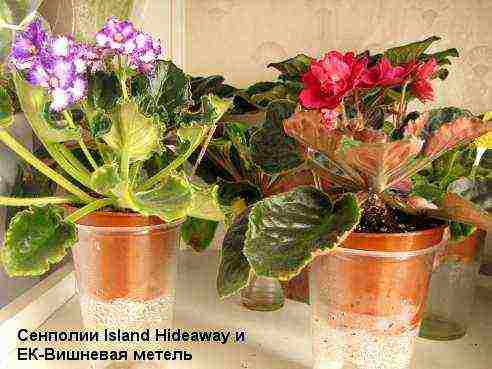
When grown on wick irrigation, the development of plants is accelerated: they grow faster, bloom faster, but, accordingly, age faster. The soil has to be changed more often due to salt deposits on the edges of the pot. Some collectors bring plants to bloom on wicks to make sure the varietal colors are correct, and then switch the plants to regular watering. When changing watering, it is recommended to transplant the plant into a new nutrient, soil.
Indicate the planting date on the pots - this makes it easier to determine if the plant needs a transplant.
Uniform development
A properly planted plant on a wick can be easily removed from a pot, the root system is very tightly wrapped around an earthen ball, and the roots are alive and white.
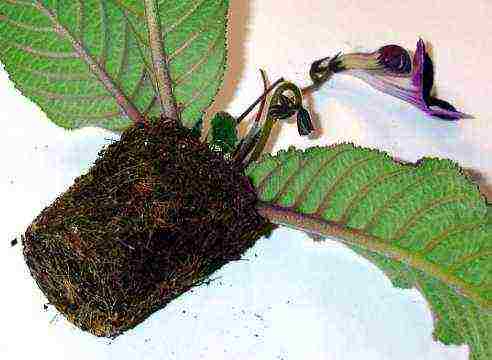
Very often the roots are so well developed that they run down the wick into a container of water (nutrient solution). There is nothing wrong with that. But if you are going to transfer the plant to regular watering or transplant, the outer roots must be cut off.
If the plant on the wick has lost its turgor, and the earthy lump is wet, immediately remove it from the wick and check the roots. If they are brown, then they are dead or rotted. In this case, the plant can only be rescued by re-rooting.
Increased humidity when growing saintpaulias stimulates the growth of lateral shoots, stepchildren. This is good if the variety is rare, because when propagated by stepchildren, the color is transmitted in 95% of cases. This is especially important when breeding chimeras. However, if you are preparing a plant for an exhibition, stepchildren need to be removed. They do not promote flowering, appearing in the axil of the leaf instead of the peduncle, moreover, the symmetry of the rosette is lost.
Summer care
If you need to leave and leave the mature plants, you can switch them from regular watering to a wick watering and run a wick between them. This should be done 2-3 weeks before departure in order to see if the earthen lump is sufficiently wetted. It happens that different plants in the same pots need wicks of different diameters - the larger the outlet, the more water it needs. Flowering plants also absorb more moisture.

